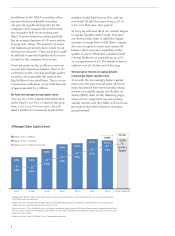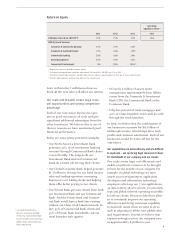JP Morgan Chase 2013 Annual Report Download - page 17
Download and view the complete annual report
Please find page 17 of the 2013 JP Morgan Chase annual report below. You can navigate through the pages in the report by either clicking on the pages listed below, or by using the keyword search tool below to find specific information within the annual report.-
 1
1 -
 2
2 -
 3
3 -
 4
4 -
 5
5 -
 6
6 -
 7
7 -
 8
8 -
 9
9 -
 10
10 -
 11
11 -
 12
12 -
 13
13 -
 14
14 -
 15
15 -
 16
16 -
 17
17 -
 18
18 -
 19
19 -
 20
20 -
 21
21 -
 22
22 -
 23
23 -
 24
24 -
 25
25 -
 26
26 -
 27
27 -
 28
28 -
 29
29 -
 30
30 -
 31
31 -
 32
32 -
 33
33 -
 34
34 -
 35
35 -
 36
36 -
 37
37 -
 38
38 -
 39
39 -
 40
40 -
 41
41 -
 42
42 -
 43
43 -
 44
44 -
 45
45 -
 46
46 -
 47
47 -
 48
48 -
 49
49 -
 50
50 -
 51
51 -
 52
52 -
 53
53 -
 54
54 -
 55
55 -
 56
56 -
 57
57 -
 58
58 -
 59
59 -
 60
60 -
 61
61 -
 62
62 -
 63
63 -
 64
64 -
 65
65 -
 66
66 -
 67
67 -
 68
68 -
 69
69 -
 70
70 -
 71
71 -
 72
72 -
 73
73 -
 74
74 -
 75
75 -
 76
76 -
 77
77 -
 78
78 -
 79
79 -
 80
80 -
 81
81 -
 82
82 -
 83
83 -
 84
84 -
 85
85 -
 86
86 -
 87
87 -
 88
88 -
 89
89 -
 90
90 -
 91
91 -
 92
92 -
 93
93 -
 94
94 -
 95
95 -
 96
96 -
 97
97 -
 98
98 -
 99
99 -
 100
100 -
 101
101 -
 102
102 -
 103
103 -
 104
104 -
 105
105 -
 106
106 -
 107
107 -
 108
108 -
 109
109 -
 110
110 -
 111
111 -
 112
112 -
 113
113 -
 114
114 -
 115
115 -
 116
116 -
 117
117 -
 118
118 -
 119
119 -
 120
120 -
 121
121 -
 122
122 -
 123
123 -
 124
124 -
 125
125 -
 126
126 -
 127
127 -
 128
128 -
 129
129 -
 130
130 -
 131
131 -
 132
132 -
 133
133 -
 134
134 -
 135
135 -
 136
136 -
 137
137 -
 138
138 -
 139
139 -
 140
140 -
 141
141 -
 142
142 -
 143
143 -
 144
144 -
 145
145 -
 146
146 -
 147
147 -
 148
148 -
 149
149 -
 150
150 -
 151
151 -
 152
152 -
 153
153 -
 154
154 -
 155
155 -
 156
156 -
 157
157 -
 158
158 -
 159
159 -
 160
160 -
 161
161 -
 162
162 -
 163
163 -
 164
164 -
 165
165 -
 166
166 -
 167
167 -
 168
168 -
 169
169 -
 170
170 -
 171
171 -
 172
172 -
 173
173 -
 174
174 -
 175
175 -
 176
176 -
 177
177 -
 178
178 -
 179
179 -
 180
180 -
 181
181 -
 182
182 -
 183
183 -
 184
184 -
 185
185 -
 186
186 -
 187
187 -
 188
188 -
 189
189 -
 190
190 -
 191
191 -
 192
192 -
 193
193 -
 194
194 -
 195
195 -
 196
196 -
 197
197 -
 198
198 -
 199
199 -
 200
200 -
 201
201 -
 202
202 -
 203
203 -
 204
204 -
 205
205 -
 206
206 -
 207
207 -
 208
208 -
 209
209 -
 210
210 -
 211
211 -
 212
212 -
 213
213 -
 214
214 -
 215
215 -
 216
216 -
 217
217 -
 218
218 -
 219
219 -
 220
220 -
 221
221 -
 222
222 -
 223
223 -
 224
224 -
 225
225 -
 226
226 -
 227
227 -
 228
228 -
 229
229 -
 230
230 -
 231
231 -
 232
232 -
 233
233 -
 234
234 -
 235
235 -
 236
236 -
 237
237 -
 238
238 -
 239
239 -
 240
240 -
 241
241 -
 242
242 -
 243
243 -
 244
244 -
 245
245 -
 246
246 -
 247
247 -
 248
248 -
 249
249 -
 250
250 -
 251
251 -
 252
252 -
 253
253 -
 254
254 -
 255
255 -
 256
256 -
 257
257 -
 258
258 -
 259
259 -
 260
260 -
 261
261 -
 262
262 -
 263
263 -
 264
264 -
 265
265 -
 266
266 -
 267
267 -
 268
268 -
 269
269 -
 270
270 -
 271
271 -
 272
272 -
 273
273 -
 274
274 -
 275
275 -
 276
276 -
 277
277 -
 278
278 -
 279
279 -
 280
280 -
 281
281 -
 282
282 -
 283
283 -
 284
284 -
 285
285 -
 286
286 -
 287
287 -
 288
288 -
 289
289 -
 290
290 -
 291
291 -
 292
292 -
 293
293 -
 294
294 -
 295
295 -
 296
296 -
 297
297 -
 298
298 -
 299
299 -
 300
300 -
 301
301 -
 302
302 -
 303
303 -
 304
304 -
 305
305 -
 306
306 -
 307
307 -
 308
308 -
 309
309 -
 310
310 -
 311
311 -
 312
312 -
 313
313 -
 314
314 -
 315
315 -
 316
316 -
 317
317 -
 318
318 -
 319
319 -
 320
320 -
 321
321 -
 322
322 -
 323
323 -
 324
324 -
 325
325 -
 326
326 -
 327
327 -
 328
328 -
 329
329 -
 330
330 -
 331
331 -
 332
332 -
 333
333 -
 334
334 -
 335
335 -
 336
336 -
 337
337 -
 338
338 -
 339
339 -
 340
340 -
 341
341 -
 342
342 -
 343
343 -
 344
344
 |
 |

1515
unable to reform the government-sponsored
enterprises (GSE) or to get the securitization
markets healthy again. This has real costs to
consumers, especially for lower credit-quality
consumers and particularly for government-
guaranteed mortgages, which have become
more expensive, more time intensive and
less available for consumers. Originators are
being more conservative because making
loans that may default has become far more
risky and costly due to:
• The highly litigious environment and
uncertainty surrounding Federal Housing
Administration (FHA) guarantees with
respect to FHA mortgages.
• The ongoing “put-back” risk and the
litigation costs around reps and warranties
from the GSEs and sophisticated private
investors.
• The increasing prescriptiveness of rules on
servicing from dierent – and sometimes
conflicting – regulators and government
agencies.
• The increasing diculty of moving
servicing – again, especially for high-risk
loans, which often are unprofitable to us and
other large financial institutions – to other
servicers that have systems and processes
better able to serve these customers.
These issues make mortgages more costly
and unpredictable for companies and far less
consumer friendly. In many cases, deserving
lower- and middle-income consumers may
pay far more than they might have in the
past for a mortgage or, worse yet, they won’t
be able to get one.
We need for all those involved in the mort-
gage business to come up with a practical
set of coherent and consistent policies that
work for originators, servicers, investors,
unprotable; therefore, over time, banks
probably will minimize this type of deposit,
and clients will seek other alternatives, prob-
ably in the money markets.
Committed, undrawn revolvers. Many clients
have large, committed, unused revolvers
so they can manage their cash flows and
not leave too much unused cash on their
balance sheet. Because new rules impose
liquidity and additional capital requirements
on committed, undrawn revolvers, the cost
involved in providing them could increase
by up to 60 basis points, depending on the
client segment and nature of the facility.
Banks will either have to charge more for
this product or focus more acutely on the
nature and value of the particular client rela-
tionship as a whole in considering whether
to make revolvers available to that client.
Trade finance. The cost of short-term trade
finance and standby letters of credit also will
increase dramatically, with pricing poten-
tially up by 75 basis points in the long term.
The rates business (mostly trading government
securities and interest rate swaps). The new
rules have a huge eect on this business
because they require substantially more
capital and liquidity. And for some banks,
the rates business has gone from profitable
to unprofitable, causing some banks to exit
the business altogether. Because of our large
volume and low costs, we already have begun
to make significant changes to this business
and expect to maintain decent profitability.
The mortgage business. The U.S. mortgage
market still faces huge hurdles and has a
long way to go before it is a well-functioning
market that is good for consumers and the
country’s economic health (and makes sense
for financial companies). There has been
a large increase in the capital required to
service and hold mortgages. Servicing itself
has become far more costly and dangerous
to the servicer – servicing costs alone have
gone up 20 basis points. We still have been
